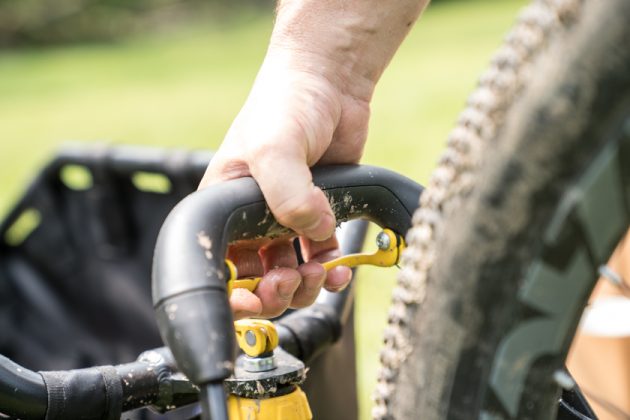Review: Burley Coho XC Trailer
Originally posted on August 20, 2018 at 0:01 am Burley Coho XC Trailer
Burley Coho XC Trailer
By Stephen Haynes
Weight: 22 lbs.
MSRP: $419
Online: burley.com
Back in 1978, there weren’t the myriad options for stowing and towing your cargo by bike that we luxuriate in today. Burley founders Alan and Beverly Scholz took it upon themselves to develop a method for transporting goods, gear and their young child safely around their community south of Eugene, Oregon.
Scavenging an old swing set and a few disused bikes, Alan concocted the original Burley trailer, so named for his bike-racing wife “Burley Bev,” and quickly began turning heads and collecting orders.
Forty years later, the company hopes its new venture, the Coho XC, will be as groundbreaking and thought-provoking as that first trailer.
I was interested in testing out the Burley Coho XC as a means of conveying my relatively heavy outdoor painting setup. I often hike for miles looking for a good place to set up, and carrying my easel and all the associated accoutrements in separate bags (or one large bag) can be taxing. My hope was to utilize the setup in a way that would allow me to get into places with relative ease that would otherwise take me hours.
The Coho XC isn’t unfamiliar in look or shape. At its core, the Burley is a single-wheel trailer that attaches to either side of the rear hub of its tow bike. It has a cargo area of 24x15x11.5 inches, and can carry up to 70 lbs. The total length of the Coho XC is just over 66 inches from tip to tail, and it stands at just over 21 inches from the ground (measuring to the height of the sidewalls).

Fitting a wide variety of tow bikes was an important design aspect for Burley. As such, the company developed a two-part solution to fit (most) any bike. The attachment yoke, which connects from the swing arm on the trailer to the tow bikes’ rear hub and a proprietary axle for the tow bike, called Burley Ballz.
Despite the lamentable name, the Burley Ballz are actually quite a triumph for connecting and disconnecting the yoke, which is also a marvel (more on that in a second). The Burley Ballz replace the tow bicycle’s rear axle and come in a wide range of sizes, including 12 mm thru-axles, to accommodate today’s emerging standards. The consumer will choose between a menu of options for rear axle replacement via the Burley website, all of which is made a little easier by way of printable chart that you can compare your current axle to before ordering.
Attaching the Burley Coho XC to the tow bike is achieved by connecting the ends of the swing arm yoke to the Burley Ballz on the rear axle. The ends have some internal latches that can be released via a hand lever. The yoke itself can be spread or narrowed to fit the myriad rear axle widths by simply pressing or pulling on the handle that has the latch pull. My explanation of it over complicates the action to the point of absurdity. It’s quite easy in practice.
Beyond the adjustable yoke and Burley Ballz, the Coho XC has a kickstand capable of holding a loaded trailer and bike upright. A nice feature. The kickstand also has three adjustment points to satisfy your needs.
Out the back, the Coho XC comes standard with a detachable rigid fender, to which can be affixed an add-on rack to carry panniers, and a 16×2.125 inch wheel. My tester came with a 16+ wheel, and as I’m a sucker for all things monster-truckish, I stuck to that one alone. The coil spring attached to the rear fork is pretty robust for a trailer as well.
In practice, the Coho XC’s ride characteristics reflect the terrain over which you are rolling. Smooth asphalt? Smooth ride. Rocky singletrack? Well, not as smooth. I took the Coho XC on a handful of local singletrack trails in my region of southwestern Pennsylvania, which varied in terrain from smooth, rolling dirt to rock-strewn, looking for places to paint.
While the trailer tracks well and doesn’t require too much oversteer, it does succumb to some side-to-side feedback when leaning, or standing and pedaling. Steep, techy bits can also be a little dicey as braking with a load attached induces a sort of brake-shimmy, and the aforementioned side-to-side play from the attachment point feels like an invisible hand trying to throw you off course. In all honesty, It sounds worse than it feels, but certainly makes you pay extra close attention to what you’re doing.
Ambling along in a single direction is fine; turning around is a bit of a chore. Ever try backing up a small trailer with a vehicle? Also, any obstacle over a certain height will stop you in your tracks (I flew over the bars attempting a small log roll). My foolishness is your wisdom I suppose …

It’s been nice not having paint gear attached to my person when looking for inspiration, and I certainly don’t lament arriving at my destination with energy to create. The Coho XC competently conveyed all my gear and allowed me to quickly grab or stow things as needed. I could easily see the trailer being employed as a tool caddy for trail work and mobile gear shed for bikepackers and grocery getters alike.
If you’ve been looking for a super stable cargo trailer that can handle it a little rough and don’t mind paying for the privilege, the Burley Coho XC cargo trailer could be the right fit for you. I’ll certainly keep using my tester right up until they demand the thing back.
